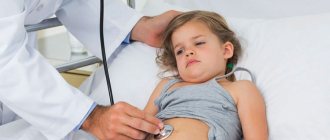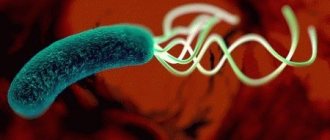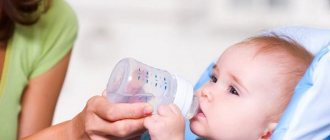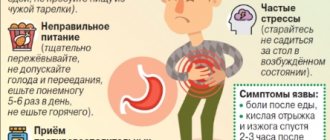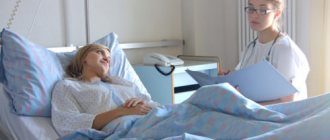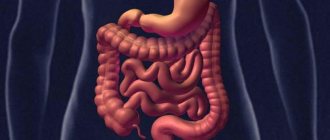How does the disease progress?
Rotavirus is an intestinal infection that also affects the upper respiratory tract. Most often, rotavirus infection is found in children aged 6 months to 5 years. The immune defense of such babies is not yet strong enough; the infection easily penetrates the body.
Sometimes this disease is also called “stomach flu”, but some experts do not consider this name to be correct. As, for example, the famous children's doctor E. Komarovsky emphasizes, influenza is a respiratory infection, and rotavirus mainly destroys the mucous membrane of the digestive system (stomach, intestines, duodenum), which leads to intestinal disorders and dehydration of the body.
Within 5 days after infection, the baby may not show any signs of illness (the so-called incubation period). Then comes the acute stage. For seemingly no reason, he wakes up crying in the middle of the night and vomits. Clear signs of poisoning appear. It is especially bad for the baby in the first 2-3 days. Recovery occurs in approximately 5-8 days. However, signs of the disease may take another 4-5 days to appear.
A large number of pathogens of rotavirus infection are released with feces, so a sick baby can easily infect other children and adults, especially in the first week. Then he is allowed to visit children's institutions if he does not experience a relapse of the disease. In order to determine that the child is completely healthy, a rota test is done (an express method for detecting rotavirus in feces). It is done by a specialist.
The disease can progress in different ways. There are 3 options possible:
- First, symptoms of a respiratory disease (runny nose, cough) appear without fever, and then signs of intestinal distress.
- Digestive upset occurs, and then other signs of rotavirus infection appear in children.
- Weakness, drowsiness appears, appetite disappears, and after a while abdominal pain and other symptoms appear. This condition often occurs in children under 1 year of age. The baby begins to press his legs to his tummy and cry.
About the disease
Evgeniy Komarovsky emphasizes that rotavirus has nothing to do with the influenza virus or any of its specific strains. Any flu can multiply and exist only on the mucous membranes of the respiratory tract. With rotavirus, everything is different; it “lives” in the small intestine, and therefore calling it the flu as a whole is not very correct.
For the first time, a virus (under a microscope resembling a wheel with hubs and a rim, and therefore called so “rota” - wheel (lat.)) was discovered in 1973 by Australian researchers. 98% of children under the age of 3 have already had this disease at least once (according to existing medical statistics).The virus is transmitted by contact - fecal-oral, this is popularly called “dirty hands disease”.
A baby can become infected from a sick person through toys, door handles, dishes, and household items. The virus is extremely contagious. Although specific immunity to rotavirus is developed, it is almost irrelevant, since this agent has many strains and varieties. Humans are attacked by completely different “modifications” of rotavirus (science knows more than 9 of them, and mutations are still ongoing).
All varieties of this virus are quite resistant to low temperatures, exposure to sunlight and air. Rotavirus survives for quite a long time in spring and sea water.
The incubation period is the time that passes after the virus enters the body until the acute stage of the disease begins. This period of time varies for different children.
A child is contagious all the time from the moment of infection until the end of the recovery period. Even if the baby already feels well, viable microparticles of the virus still continue to be released in the stool.
That is why Komarovsky strongly does not recommend sending him to kindergarten or school immediately after the child feels better. This will certainly lead to mass infection in the children's group.
The likelihood of infection with rotavirus does not in any way depend on the cleanliness of the family. Even if the mother washes and vacuums everything several times a day, if she forces the child to wash their hands with soap every hour, carefully monitors the quality of every product that ends up on the table, and does not allow them to drink water of dubious origin - all this does not reduce the risk of contracting rotavirus.
The virus most often attacks children aged 6 months to 2 years. In general, children from birth to 5 years of age are at risk. In a newborn, this disease occurs somewhat less frequently, since the first six months after birth the child is favorably influenced by the mother’s “innate” immunity, which usually lasts for a maximum of six months. Then the baby becomes more vulnerable.
The World Health Organization provides the following figures: every day on our planet, about 125 million children become infected with rotavirus. Most recover fairly quickly and on their own. 2 million children end up in hospitals, about 500 thousand toddlers die, but not from the rotavirus infection itself, but from the severe complications that occur during its course.
Symptoms of infection
The main symptoms of rotavirus infection are vomiting, diarrhea, and fever. Due to severe vomiting, it is impossible to give the patient water to drink; it immediately comes back out.
The baby develops cramping abdominal pain and diarrhea. On the first day, stool is copious and frequent (the urge occurs 10-15 times a day). The color of feces is yellow, the consistency is liquid, foamy, the smell is sour. In subsequent days, the stool becomes thicker and its color is yellowish-gray. The pain occurs mainly in the navel area.
The temperature rises to 39 degrees and above. It is difficult to bring it down with conventional antipyretics.
Warning: Vomiting and diarrhea may be symptoms of food poisoning. The difference is that in case of poisoning, the child feels better after he vomits or has a bowel movement. But with an intestinal infection there is no relief after attacks. Therefore, in order to understand what the baby is sick with, you need to ask him if he feels better.
In addition to these symptoms, a child with rotavirus infection also develops others: loss of appetite, headache. The baby becomes lethargic and drowsy.
The first signs of rotavirus: how the disease begins in a child at 1 year-2 years and older
The incubation period is very short, a maximum of two days, sometimes up to five . The first signs may not necessarily be of a gastrointestinal nature. Sometimes rotavirus infection in children, the symptoms of which are described below, initially resembles a respiratory disease and is characterized by :
- temperature rise,
- runny nose,
- discomfort in the throat.
A manifestation of rotavirus may also be that the baby has difficulty swallowing and may refuse to eat. Therefore, rotavirus is often called “stomach (or intestinal) flu.” First aid actions depend on how the disease manifests itself.
The disease is accompanied by significant intoxication of the body . This shows up:
- pale skin,
- weakness,
- lethargy,
- the baby may sleep unnaturally for a long time,
- turn away from the game,
- be capricious.
Often there are no preliminary signs. It all starts suddenly with vomiting or diarrhea. The stool is liquid and foamy. All other signs join and intensify as the disease progresses.
How an infection can enter the body
Rotavirus enters the baby's body through the mouth. A six-month-old baby learns to crawl, pulls various objects into his mouth, and sucks his fists. Therefore, it can easily become infected. Rotavirus infection can be found on poorly washed hands, in dust on toys or furniture. Eating unwashed vegetables and fruits is also a cause of infection.
Rotavirus is present both in feces and in saliva or nasal mucus. If the patient does not wash his hands well after using the toilet, and then touches the door handles, then an infection remains on them, which is transmitted to the baby and other family members. Usually everyone gets sick in turn, but in adults the symptoms are not so severe (1-2 days of nausea, maybe diarrhea). Sometimes they do not feel signs of the disease at all, but are virus carriers.
Parents of a child cannot always figure out that the cause of a runny nose, dry cough and conjunctivitis is rotavirus infection. Another child, after communicating with the sick person, easily becomes infected.
Often, outbreaks of rotavirus infection occur at marine recreation centers, where infection occurs through dirty sea water or sand, where sanitary and hygienic conditions are far from normal. Children easily become infected in kindergarten or school. Infection is possible in hospitals where there are virus carriers, children or adults.
Video: Signs of rotavirus infection, diagnosis, principles of treatment, effectiveness of vaccination
Rotavirus infection (rotavirus, stomach flu)
Rotavirus infection is an infectious disease caused by rotavirus; there are also other names - rotavirosis, rotavirus gastroenteritis, intestinal flu, stomach flu. The causative agent of rotavirus infection is a virus from the order of rotaviruses (lat. Rotavirus). The incubation period of infection is 1-5 days. Rotavirus affects both children and adults, but in an adult, unlike a child, the disease occurs in a milder form. The patient becomes contagious with the first symptoms of rotavirosis and remains contagious until the end of the manifestation of signs of the disease (5-7 days). After 5-7 days, recovery occurs, the body develops strong immunity to rotavirus and re-infection occurs very rarely. In adults with low antibody levels, symptoms may recur.
Routes of transmission of rotavirus infection
The route of transmission of rotavirus is mainly food (through unwashed food, dirty hands). You can become infected with rotavirus infection in a variety of ways, for example, through contaminated food products, especially dairy products (due to the specifics of their production). Rotaviruses thrive in the refrigerator and can live there for many days; chlorination of water does not kill them. In children aged 1 year and older, rotavirosis may appear when visiting nurseries, kindergartens and schools, since the new environment contains different viruses and microbes than at home or in a group where the child has been for a long time.
This infection can also be classified as a “disease of dirty hands”. In addition, since rotaviruses cause inflammation in the respiratory tract, they, like influenza viruses, are spread by droplets - for example, by sneezing.
The virus penetrates the mucous membrane of the gastrointestinal tract. The mucosa of the small intestine is mainly affected. Rotavirus infection affects the gastrointestinal tract, causing enteritis (inflammation of the intestinal mucosa), hence the characteristic symptoms of rotavirus.
Symptoms of rotavirus infection in children
There is an incubation period (1-5 days), an acute period (3-7 days, in case of severe disease - more than 7 days) and a recovery period after illness (4-5 days).
Rotavirus infection is characterized by an acute onset - vomiting, a sharp increase in temperature, diarrhea is possible, and often very recognizable stools - liquid yellow on the first day, gray-yellow and clay-like on the second and third days. Most patients develop a runny nose, redness in the throat, and experience pain when swallowing. During the acute period, there is no appetite and a state of loss of strength is observed. Long-term observations have shown that the largest outbreaks of the disease occur during or on the eve of an influenza epidemic, for which it received the unofficial name “intestinal flu.” Feces and urine are very similar in appearance to the symptoms of hepatitis (light stool, dark urine, sometimes with flakes of blood).
What complications may there be?
Rotavirus infection is quite dangerous for children. During illness they experience the following complications:
- Dehydration of the body. This condition occurs due to large loss of fluid during vomiting and diarrhea. It is very dangerous for a small child and leads to his death. The baby needs to drink a lot of lightly salted water. If it is impossible to give him something to drink, then the solution is administered through a dropper.
- Acetonemic syndrome. Due to dehydration of the body, metabolic disorders occur. At the same time, acetone and acetoacetic acid accumulate in the blood, causing poisoning, increasing vomiting, drowsiness, lethargy, and stomach pain. You can smell acetone from your mouth.
- Cramps. They can occur in babies due to high body temperature. It needs to be brought down not only with the help of antipyretics, but also by wiping the children (for example, with alcohol diluted half with water).
- Damage to the nervous system, which manifests itself as fainting and delirium. In this case, seizures appear at normal or slightly elevated temperatures. This complication occurs as a reaction of the body to toxins.
Advice: Considering the possibility of such severe complications, if a child experiences diarrhea and frequent bouts of vomiting, it is imperative to consult a doctor so that the baby can receive timely help.
Symptoms
Interesting: The disease is rare in children under one year of age. This is facilitated by breastfeeding, which provides the baby with passive immunity to viruses.
The first symptoms of rotavirus infection in children appear quite quickly. As a rule, 1–2 days after the virus enters the body. At the initial stage of development of the disease, signs of a common acute respiratory infection appear. The child may have a stuffy nose, a cough and an accompanying sore throat and fever. But after a few days, the characteristic symptoms of rotavirus infection in a child make themselves felt.
Symptoms of rotavirus infection in children:
- Intoxication. In children aged 1 year, the disease can begin with a lack of appetite and loss of strength. The baby becomes whiny, refuses to breastfeed, moves little, and sweats profusely. Over the age of 1–2 years, the baby may complain of a headache.
- Temperature. In most cases, there is a high temperature for 3 days, which can reach 39 degrees. Then there is a decrease in it, with the remaining symptoms remaining the same. The temperature can last up to 7 days if we are talking about a complex form of the disease.
- Diarrhea.
In children under 2 years of age, bowel movements can occur up to 14 times a day. The situation can last up to 2 weeks. The baby usually defecates with liquid, foamy stool, which often contains particles of mucus. At the same time, water leaves the body, which leads to dehydration. - Vomit. It lasts for 48 hours in babies under 1 year old, and, as a rule, for 24 hours if the second year has passed. Vomiting may occur several times during the day. It, like diarrhea, causes the body to lose fluid.
- Painful sensations in the abdominal area. The pain can cause discomfort throughout the day, periodically intensifying, especially if you palpate the child’s abdomen in the middle and lower parts.
Rotavirus manifests itself differently in children. As a rule, older children tolerate it more easily than those who were under two years old at the time of illness. The course of the disease also depends on the characteristics of the body.
With the appearance of the first symptoms of this disease in the baby, a visit to the doctor should become mandatory, as well as subsequent treatment.
Parents should be alert to the following symptoms that have been added to rotavirus infection:
- A change in the color of stool to black, the appearance of blood in it, and an unpleasant odor. Such reasons may indicate bleeding in the intestines.
- Frequent vomiting (more than 7 times in 24 hours) and diarrhea (more than 10 times). This can lead to dehydration.
- Growing, unremitting pain in the abdominal area. It can occur as a result of damage to the intestinal walls.
- Skin rashes may indicate another pathology - typhoid fever (paratyphoid), which requires special treatment and is disguised as rotavirus.
Treatment
For viral diseases, antibiotics are powerless. There are no drugs that affect rotavirus. Treatment is required not for the infection itself, but for the symptoms of the disease caused by it (symptomatic therapy). It is aimed at alleviating the baby’s condition and preventing dangerous complications.
Fighting dehydration
The greatest danger for the baby is diarrhea and, as a result, dehydration. To prevent this from happening, first of all, measures are taken to replenish fluid reserves and restore salt metabolism. The baby is given a weak salt solution or rehydron diluted with water to drink. It is taken in small portions, but often, after each attack of vomiting.
Detoxification of the body
Nausea, vomiting, diarrhea - all these are signs of poisoning of the body with waste products of rotavirus. One of the important elements of treatment for rotavirus infection is detoxification. Frequent intake of rehydron solution not only helps restore water-salt balance and maintain metabolism, but is also necessary for removing toxins in the urine.
In order to reduce the toxic effect, the child must also be given sorbents (activated carbon, smecta, enterosgel). They absorb harmful molecules and viruses, but are not absorbed by the mucous membrane of the stomach and intestines, but are completely eliminated. Taking sorbents helps reduce gas formation and bloating.
Reducing fever
Increasing body temperature is the body's way of fighting the virus. Therefore, in case of viral infections, it is recommended to lower the temperature only if it exceeds 38 degrees. At higher temperatures, babies may experience seizures. Antipyretics are given in the form of special children's syrups (Nurofen or Panadol). For very small children, it is more convenient to use suppositories with paracetamol (for example, cefekon).
Elimination of intestinal pain
Disruption of the normal environment in the stomach and intestines, fermentation and gas formation lead to spasms and severe pain. In addition to sorbents, it is necessary to give medicine that relaxes the intestinal muscles and eliminates spasms. No-spa is usually used.
Restoration of microflora
The treatment ends with the restoration of the intestinal microflora in children. In a healthy intestine, beneficial lactobacilli predominate, which suppress the development of harmful microorganisms. When a virus enters, lactobacilli die, and harmful microflora begins to multiply. Restoring the natural composition of the intestinal environment accelerates the destruction of the virus.
Acipol, Linex and the like are used as preparations containing beneficial bifidobacteria.
Features of treatment
The treatment uses an integrated approach. In addition to the use of medications, dietary adjustments are necessary to speed up recovery. When it comes to children, self-medication is strictly prohibited. The prescription of drugs is carried out by a doctor, taking into account the age and characteristics of the child’s body, as well as the nature of the disease and the risk of negative consequences while taking a particular medicine.
How to deal with dehydration?
The primary goal of drug therapy is to restore the body's water balance. For this purpose, the infant is recommended to drink plenty of fluids. The following will help replenish lost fluid:
- rehydrating agents for oral administration Regidron, Humana Electrolyte, Oralit, Glucosolan, Normohydron;
- saline aqueous solutions.
How to restore intestinal microflora?
A malfunction of the digestive system caused by rotavirus inevitably leads to disruption of the child’s intestinal microflora. To restore it, children are prescribed probiotic drugs (Linex, Bifidumbacterin, Lactobacterin). Dosages and duration of use of this group of drugs are individual.
Along with this, the use of enzymes (Pancreatin, Creon, Mezim Forte, Panzinorm) is recommended. Enzyme preparations gently and effectively normalize digestion and restore the normal process of bowel movement.
Do I need to use antipyretics?
Antipyretic drugs are prescribed to children only if the body temperature exceeds 38 degrees. At lower rates, there is no need to use this group of drugs, since minor hyperthermic syndrome indicates the body’s attempts to independently repel the attack of pathogenic microorganisms. To eliminate hyperthermia in infants, preference is given to antipyretic rectal suppositories. The most effective drugs for reducing body temperature in children include rectal suppositories Efferalgan, Panadol, Paracetamol, Cefekon, Viburkol.
Baby food
Treatment of symptoms of rotavirus infection in an infant requires mandatory nutritional correction. Pediatricians do not recommend stopping breastfeeding during illness. However, you need to reduce the number of times your baby attaches to the breast. The baby should be fed as needed, carefully monitoring his body's reaction. For formula-fed children, it is recommended to replace regular infant formula with lactose-free options. If complementary feeding is introduced into a child’s diet, it is necessary to completely abandon the use of dairy products.
The role of diet
Diet, exclusion from the diet of certain foods that irritate the mucous membrane, cause bloating or have a diuretic effect, which contributes to dehydration, play a decisive role in the treatment of rotavirus infection in children.
Seasonings, milk, fresh vegetables and fruits (cucumbers, tomatoes, plums, apples) should be completely excluded from food. It is allowed to give the child low-fat fermented milk products (the lactic acid they contain helps replenish the intestines with lactobacilli).
Fats (butter and vegetable oil) are completely excluded. Food is given only in boiled form. Towards the end of the illness, the child can be given a baked apple, as well as a banana. Any carbonated drinks are prohibited.
After vomiting, it is better to feed the child with semi-liquid cereals and jelly. By enveloping the intestinal walls, such products protect them from irritation and promote rapid healing of microdamages. You can give stewed carrots and pumpkin puree.
The main rule, as Dr. E. Komarovsky emphasizes, is not to force the child to eat, especially on the first day, when he vomits. During sick days, an infant can be fed only with mother's milk.
Video: Diet for children of different ages with rotavirus infection
What to feed a child with rotavirus infection
Intestinal diseases, especially in children, are often accompanied by a decrease in appetite. This is a good signal not to force feed your baby. On the first day of illness, he should be offered unsweetened rice porridge, baked apples, and white bread crackers.
Later, you can add boiled lean meat, vegetable soups, water porridge, pasta, and dairy products to the menu. Let the portions be small - it is better to increase the frequency of feeding to 5-6 times a day. It is not recommended to expand the list of what to give a child for rotavirus infection to include decoctions and herbal tinctures.
- With a child on the road - how to avoid motion sickness
- Composition of a children's travel first aid kit
Rotavirus infection in children under one year of age on artificial feeding is easier if the child is switched to low-lactose, lactose-free, and fermented milk formulas. This is due to the fact that rotavirus inhibits lactase (an enzyme that breaks down milk sugar). Breastfeeding is usually not recommended to stop during illness.
Disease prevention
Avoiding infection with rotavirus if a child attends kindergarten is very difficult. If the risk of disease is increased, as in this case, then the child can be vaccinated. The vaccine contains a strain of rotavirus in a minimal concentration. The baby develops immunity, just like after a real illness. In this case, treatment of rotavirus infection will either not be needed at all, or will be significantly simplified. Even if the disease occurs, it will be in a much milder form, without complications.
The likelihood of your child getting sick can be reduced by keeping his hands clean. Before the child sits down at the table, he must wash them with soap. It is necessary to ensure that the baby does not grab the potty with his hands while in the toilet. Toys that he puts in his mouth must be washed thoroughly.
Viruses and bacteria are found on the surface of fruits and vegetables. Therefore, they must be peeled or doused with boiling water after washing.
The room must be clean. If someone in the family is already sick with rotavirus, you should try to protect the child from contact with the sick person.
When identifying a rotavirus infection transmitted through contaminated food or through personal contact, the expression “dirty hands disease” is used in medical slang. It should be noted that the standard of living, the civility of society, careful adherence to hygiene measures and living conditions do not play a special role in shaping the risk of morbidity, that is, every child gets sick at least once in their life, regardless of care and social status.
Rotavirus: treatment in children
Experienced parents know that when a child experiences vomiting or diarrhea, it is important to replenish lost fluid. Actually, this is the treatment of rotavirus infection in children and adults.
In this case, your home and travel first aid kit must have oral rehydration products. They restore the water-salt balance of the body. There are several dozen names of such funds. They are usually powders that must be dissolved in water and drunk according to the instructions. If you don’t have such products on hand, you can prepare a treatment solution yourself: dissolve 2 tablespoons of sugar, 1 teaspoon of salt and 1 teaspoon of baking soda in 1 liter of boiled water.
You need to give your child water so often that he urinates at least once every 3 hours. When treating children under one year of age, oral hydration solution can be poured into a bottle, spoon-fed, or poured into the child's mouth using a syringe without a needle.
It happens that due to vomiting, the liquid does not have time to be absorbed. In this case, it is useful to give the child food in small portions, 20-40 ml, at short intervals (no more than 10 minutes).
During treatment of infection in children under one year of age, a single volume of liquid can be 5-10 ml.
If you suspect rotavirus in an infant, treatment will have one caveat: during the illness and for 2-3 weeks after it, it will be necessary to limit milk consumption. You will read about the rules of nutrition during rotavirus infection in our article. Sometimes there are other recommendations on how to treat rotavirus in a child. In particular, it is recommended to give sorbents, antidiarrheal and antiemetic agents. Such medications can only be used as prescribed and under the supervision of doctors. There is currently no antiviral medicine for rotavirus that has been proven effective. However, rotavirus is definitely not treated with antibiotics: their use can only worsen the condition, since it has a depressing effect on the intestinal microflora.
What is rotavirus infection?
Rotavirus infection (intestinal flu, rotavirus gastroenteritis) is an infectious pathology of the digestive tract, accompanied by symptoms of general intoxication and dehydration (dehydration) of the body. This disease is typical for all age groups, but children from six months to 3 years are most often infected.
According to statistics, in recent years the incidence of rotavirus infection among young children has increased significantly (up to 60%). According to experts, the reason for this phenomenon lies not only in the increase in the absolute number of diseases associated with deteriorating sanitation and hygiene, but also in the expansion of laboratory diagnostic capabilities.
Every year, 440 thousand children worldwide become victims of rotavirus infection and die from diarrhea. The most vulnerable are children from one to three years old. This is explained by the fact that at this age there are no antibodies to rotavirus in the child’s body. Up to one year of age, children receive maternal antibodies through breast milk. At the same time, babies who are bottle-fed have a fairly high chance of getting sick.
Clinical forms of the disease:
- Gastroenteric (gastrointestinal).
- Enteric (intestinal).
Causes of rotavirus infection
The causative agent of intestinal infection is rotavirus from the reovirus family. The RNA virus got its name (rota means wheel in Latin) because of its resemblance to a small bicycle wheel with a wide hub, hub, clearly defined rim and spokes. The diameter of viral particles can vary between 65-75 nm. Based on their antigenic properties, rotaviruses are divided into 9 serological types. Types 1-4, as well as types 8 and 9 of the virus are contagious to humans.
The pathogen has an outer and inner protein shell (capsid). Virions lacking an outer capsid, which are often isolated from the feces of sick people, do not have infectious activity. The rotavirus genome is presented in the form of double-stranded RNA, consisting of 11 fragments.
The virus is capable of maintaining its viability on environmental objects for several months, tolerates the effects of ether and acids, is relatively resistant to disinfectants, and quickly dies when heated.
Rotavirus infection most often occurs in the winter and spring. At the same time, sporadic outbreaks of the disease can be recorded throughout the year.
Prevention of rotavirus
Although, according to the observations of doctors, almost all children suffer from rotavirus infection, it is possible and necessary to prevent the disease. The most effective remedy today is the rotavirus vaccine.
There are 2 vaccines registered in the world, one of which is effective against the most common rotavirus type A, the other - against several types.
Both vaccines come in droplet form and contain weakened viral particles. WHO highly evaluates the effectiveness of the vaccine: according to available data, it protects the child by 70-80% from the disease and by 90% from severe disease.
It should be noted that vaccination in children is effective only if done between 6 weeks and 4 months. A child older than 6 months has a high chance of encountering rotavirus and gaining immunity by surviving this disease. In this case, immunity is developed only to the type of virus that the body has encountered. Many countries around the world carry out routine vaccination against rotavirus infection. But in Russia, Ukraine and other countries of the former USSR, parents must still take care of their child’s vaccinations on their own. This vaccination can be done in commercial clinics. If, due to the child’s age, there is no longer any point in vaccinating him, he will have to resort to other measures to prevent rotavirus infection in children.
First of all, this is compliance with the rules of hygiene: washing your hands after each visit to the toilet, after walking, playing with other children and contact with animals, before eating.
A child should be taught to thoroughly wash his hands from an early age - WHO has even developed instructions on how to do this correctly.
Particular attention should be paid to disease prevention if someone in the family has signs of rotavirus infection. If possible, a sick person should be placed in an isolated room, given separate utensils, and contact should be limited.
It is recommended to wash your hands as often as possible, change hand towels and keep the bathroom clean. As we have already noted, prevention after contact with a sick person does not always lead to a positive result: the virus is highly contagious, and a person becomes contagious even before the first signs of the disease appear.
Mechanism of disease development
The source of the disease is a person with an acute form of manifest infection, or a virus carrier who releases the pathogen into the external environment along with feces. The highest concentration of virions in feces is recorded in the first 3-5 days of the disease. This period is considered the most dangerous epidemiologically. Often the source of infection for young children is their own mothers infected with rotavirus. At older ages, infection occurs in children's groups.
Etiology and epidemiology
Rotaviruses are resistant to environmental factors. Microbes do not die when exposed to low temperatures, ether, chlorine, formaldehyde, ultrasound. In hospital settings, the only disinfectant for them is ethanol. Viruses lose their pathogenic properties during prolonged boiling or treatment with alkalis and acids.
There are nine known types of rotaviruses that are dangerous to humans. Sick people release pathogens into the external environment with feces and saliva. Healthy carriers of the virus also often become a source of infection. The main mechanism of transmission of rotavirus infection is fecal-oral, which is realized through alimentary, water and contact-household routes through dirty hands, contaminated food, water, toys, and household items. In more rare cases, infection occurs through airborne droplets; the pathogen is transmitted by sneezing, kissing or coughing.
Rotaviruses often cause nosocomial infections, especially in children's hospitals, neonatal pathology departments and neonatal centers.
Factors contributing to intrauterine infection with rotaviruses: cold season, long stay in hospital, overcrowding in wards. Medical personnel are often identified as carriers of viruses.
Symptoms of rotavirus infection in children
Rotavirus infection is a disease that has a cyclical course. The duration of the incubation period is 1-4 days (usually 12 hours or a day). Usually the disease begins acutely, with an increase in body temperature to 39-40 C. Strong rumbling and pain in the abdomen, profuse fetid watery stools (up to 20 times a day) and repeated or repeated vomiting appear, starting from the very first hours of the disease, even under empty stomach or after consuming a little more than 50 ml of liquid. After eating, undigested food pieces are found in the vomit. Often the volume of vomit exceeds the amount of food and water the child received. It is quite difficult to reduce body temperature during rotavirus infection and it can remain at around 39 C for 5-6 days. Infants with the development of the disease experience severe rumbling in the stomach, rapid weight loss, lethargy and drowsiness.
As the pathological process progresses, exicosis (dehydration of the body) develops due to the loss of a large amount of fluid. The clinical manifestations of this condition depend on the severity of the disease. Mild and moderate cases are characterized by pale skin, weakness and thirst (I-II degree of dehydration). In severe cases of rotavirus infection, diuresis decreases, acrocyanosis develops, the voice becomes hoarse, and involuntary contraction of the muscles of the limbs is possible (dehydration of the third degree).
Exicosis is observed in 70-75% of hospitalized children, but in 95% of cases it occurs in mild to moderate severity, and only in 5% of cases there is severe dehydration with decompensated metabolic acidosis.
The development of dehydration is signaled by the following signs: constant thirst, sunken eyes and fontanel, dry skin, sclera and mucous membranes. The skin acquires an earthy-gray tint, lips become bright and dry, skin turgor decreases, and the amount of urine decreases. The most dangerous condition is considered to be the stage of dehydration, in which thirst is replaced by a complete refusal to drink.
In some cases, the disease may occur in a subacute form. In this situation, the child becomes lethargic and capricious, his appetite decreases, fatigue increases, general weakness and headache develop, discomfort and rumbling in the abdomen occur, and moderately severe catarrhal phenomena are observed (tretting in the throat, hyperemia of the pharynx, nasal congestion, mild cough and swollen cervical lymph nodes). This condition can last 3-4 days. Pediatricians often mistakenly mistake signs of a subacute course of rotavirus infection for acute respiratory infections or acute respiratory viral infections.
The most characteristic difference between diarrhea caused by rotavirus and dysentery or salmonellosis is the absence of mucus, greens and blood impurities in the stool, as well as the absence of tenesmus (painful false urge to defecate). In very young children, stool may become discolored without changing its consistency. The average duration of diarrhea is 5-6 days. In the first 2-3 days, the stool is watery, and then becomes clay-like, with a characteristic gray-yellow color. Catarrhal symptoms disappear in 3-4 days. As a rule, after the body produces antibodies against the virus, the disease ends in self-healing.
If blood impurities are found in the stool, this signals the addition of a bacterial infection (escherichiosis, shigellosis, campylobacteriosis). In such children, symptoms of general intoxication are more pronounced. As for the catarrhal signs of rotavirus infection, many experts also consider them to be a consequence of the layering of a secondary bacterial infection.
Specific immunity to rotavirus, caused by secretory and humoral antibodies, is formed in early childhood, after an illness. It should be noted that immunity is unstable, and with a low level of antibodies in adulthood, a relapse of the disease is possible.
Asymptomatic
Asymptomatic rotavirus infection does not occur in childhood. The disease debuts with clinical signs of respiratory catarrhal phenomena. That is why rotavirus infection is called intestinal flu.
Rotavirus does not occur without diarrhea. In mild cases, the stool changes: it becomes mushy and grayish in color.
Adults with sufficiently strong immunity act as carriers of the virus and do not feel signs of developing the disease. Mild course - the disease is carried on the legs without diarrhea and vomiting, accompanied by minor abdominal pain and nausea. The course of the disease without vomiting and diarrhea leads to infection of relatives and colleagues.
Adults rarely get sick with rotavirus infection. It was believed that the disease was a prerogative of childhood.
On palpation, patients experience pain in the epigastric region, around the navel. Rumbling and transfusion in the right iliac region are characteristic. The liver and spleen do not change in size during rotavirus infection and are painless on palpation. Abdominal pain is mild or absent.
During sigmoidoscopy, severe hyperemia and swelling of the mucous membrane of the rectum and sigmoid colon are observed.
In the acute period of rotavirus, changes in the urine are observed: blood and protein appear in the urine. The amount of residual nitrogen in the urine increases. On the first day, leukocytosis appears. Later it gives way to leukopenia. The erythrocyte sedimentation rate is unchanged.
The disease in children has a particularly aggressive course, quickly affecting the intestinal tract, leading to a characteristic clinical picture. Adults who suffered a rotavirus infection in childhood may not even be aware of the course of the disease; more often they are only carriers of the virus. Sometimes there are signs of a mild intestinal disorder that go away quickly and on their own.
The first signs in children are nausea, weakness, loss of appetite, vomiting (in infants - excessive regurgitation of fresh milk mass). Other features of the childhood course of the disease are diluted stools, increased frequency of bowel movements, and stool takes on a yellowish-greenish tint.
Additionally observed:
- weakness;
- apathy or moodiness;
- pale skin;
- blue discoloration of the nasolabial triangle in respiratory disorders;
- refusal of food, breast, formula;
- increased tone of the abdominal muscles, “acute abdomen” syndrome.
The consistency of stool is liquid, after a while it generally resembles cloudy water. Almost always, children develop a high temperature (as a result of an immune reaction to pathogenic agents), and cramping, spasmodic pain appears in the navel and abdomen.
Diagnostic features of rotavirus infection in children
- This disease is characterized by autumn-winter seasonality, high contagiousness (infectiousness), epidemic or sporadic outbreaks. Rotavirus infection primarily affects young children (one to three years).
- Distinctive signs: acute onset, fever, vomiting and secretory diarrhea.
- From the first day of the disease, a typical combination of respiratory and gastroenteritis scatological syndrome is observed.
- Lack of mucus, blood and greens in the stool.
- Absence of “finds” during routine bacteriological examination of the intestinal group of microorganisms.
Laboratory diagnosis of rotavirus infection
Virological examination of feces (electron or immunoelectron microscopy of biomaterial to detect rotavirus or viral antigen) and isolation of the virus in cell cultures.- Serological study (detection of rotavirus antigen by ELISA, RN, RSK, RNGA, latex agglutination).
If the presence of a mixed infection is suspected and questionable results of serological and virological studies are obtained, retroromanoscopy with aspiration biopsy of the colon mucosa can be used as an additional diagnostic technique (this study is carried out in especially severe cases).
Treatment of rotavirus infection
The main goal of anti-rotavirus therapy is to combat intoxication and dehydration of the body, as well as disease-related disorders of the cardiovascular and excretory systems. Hospitalization is carried out according to clinical indications. For mild to moderate forms of rotavirus infection, the child can be treated at home. Before you begin to effectively eliminate symptoms, it is necessary to establish the degree of dehydration of the body. In case of I-II degree of dehydration, the patient is given oral dehydration therapy, which involves the use of drugs that restore the water-salt composition of the blood (Rehydron, Gluxonal, etc.). The child is regularly given small doses of the solution for 13 days until stool is completely normalized.
With the development of stage III dehydration, the use of combined oral and parenteral rehydration therapy is recommended. For intravenous administration (stream or drip) acesol, quartasol, trisol are used. In especially severe cases, the child is prescribed rheosorbilact, polyglucin, hemodez and other macrodextrants.
In the acute period, to accelerate the normalization of stool and remove the virus from the body, astringent and adsorbent substances (carbolene, polyphepane, smecta, enterosgel, etc.) are used. These medications should also be given to the child for three days, in accordance with the instructions.
Due to the fact that many children suffering from rotavirus gastroenteritis develop intestinal dysbiosis, in complex therapy it is recommended to use biological preparations containing lactobacilli (lactobacterin, acylact, etc.). During their metabolism, they are capable of producing substances with antibiotic activity and replacing lactase.
To increase the concentration of antibodies to pathogens of intestinal infections, taking anti-rotavirus immunoglobulin or complex immunoglobulin preparations for enteral use is indicated. These products significantly reduce the time of intoxication and diarrhea.
Immunoglobulin preparations may only be used with the permission of the attending physician!
After a decrease in body temperature and cessation of vomiting and diarrhea for 10 days, the child should be given enzyme preparations that help normalize digestion and optimal absorption of food. Most often prescribed are Pancreatin, Festal, Mezim-Forte, Creon, etc.
Causes of pathology
Infectious processes in the intestines are caused by viral microorganisms of the genus Rotavirus.
The causative agent of rotavirus infection
Pathogenic microbes - virions, are transmitted by the oral-fecal route:
- Upon contact with objects. Through toys, linen, dishes, furniture and even the walls of the room that the sick baby touched.
- Through food . The causative agents of intestinal infections: dysentery, typhoid fever - enter with unboiled milk or water, unwashed fruit, and poor-quality food.
- Through biomaterial . Virions of rota infection settle in saliva, urine, and nasal mucus.
Most often, infection occurs in crowded places: schools, kindergartens, early childhood groups. Infection is caused by viruses entering the oral cavity. This is why it is so important to supervise hand washing among children.
You need to know that rotavirus is contagious. The infection can cause an epidemic. Most often, the disease is recorded in autumn or winter. If at least one patient with rotavirus appears in a children’s group, then after 3–5 days the pathology appears in other children who come into contact with the infected person.
Rotavirus in children is also called the disease of dirty hands or intestinal flu, although, as a rule, intestinal infection has nothing to do with colds.
Diet for the treatment of rotavirus infection
When treating intestinal infections that provoke the development of fermentopathy, special attention is paid to diet. Since the development of the pathological process disrupts the activity of a number of digestive enzymes, in particular lactase, during the acute period of the disease, whole milk and dairy products should be excluded from the child’s diet and the intake of foods rich in carbohydrates (sweet fruits, fruit juices, baked goods, legumes) should be limited. culture). Also, during the acute period of illness, it is not allowed to feed children meat, broths, meat products, fatty and fried foods. Food is given to a sick child often, in small portions. The list of permitted foods includes slimy porridges, vegetable purees and soups, white crackers and baked apples.
Breastfeeding in the presence of an intestinal infection is not stopped, since breast milk contains antibodies that neutralize rotavirus and immunoglobulins, which alleviate the course of the disease.
It is very important to follow the correct drinking regime when treating rotavirus infection. With profuse vomiting and severe diarrhea, the child’s body requires constant replenishment of lost fluid. You should drink slowly, in small sips, with breaks of 5-10 minutes. After each attack of vomiting, an infant should be given 50 ml of liquid, at an older age - 100-200 ml. In case of significant dehydration, the drinking regime should be prescribed by the attending physician.
The drinks used are still mineral water, tea or water with lemon, cranberry juice, chamomile decoction, as well as special saline solutions.
Author: Rotavirus · Published 07/22/2018 · Updated 06/05/2019
No matter how wonderful and caring parents you are, your children will definitely get sick from rotavirus infection. Doctor Komarovsky
Signs in children. How does rotavirus infection begin?
From the first days the child shows signs:
- lethargy, drowsiness;
- the skin becomes pale;
- by the evening of the first day, the baby begins to complain of cramping pain in the tummy and nausea;
- very frequent vomiting begins, which turns into loose stools with an unpleasant sour odor;
- In children, the temperature rises with rotavirus to 38-40 degrees.
Respiratory signs of the disease include runny nose, cough, inflammation and redness of the throat.
First aid for rotavirus in a child. What to do at home at the first signs?
Rotavirus infection, if it is not advanced, can be completely dealt with at home. No hospitalization.
- First of all, call your local doctor, or if you caught rotavirus on a day off or at night, then it’s better to call a children’s emergency room, because an ordinary ambulance in 99% of cases immediately offers to take the child to a children's infectious diseases hospital (do not rush there too much if you are sure that it is rotavirus, and you are just at the beginning of the disease. The main thing is to assess whether you are able to prevent severe loss of fluid in the child’s body
- Prepare plenty of towels and burp containers
- Send your loved ones or neighbors to the pharmacy to buy NoSpa, antipyretics, rehydron, water and a syringe for dosing the child.
How to treat in children
Most often, the virus proceeds without complications, but subject to timely and correct treatment. Treatment consists of relieving symptoms of intoxication in the body and restoring balance in it while following a diet.
It is difficult to diagnose rotavirus in infants because the child cannot tell anything. Quite often, the first signs are rumbling in the stomach, drowsiness, and crying. Only when vomiting and signs of diarrhea appear can a correct diagnosis be made. To make an accurate diagnosis, laboratory diagnostics are needed - detection of the virus in feces and vomit.
How to stop vomiting
Vomiting usually occurs every 15-20 minutes. Only an injection of Cerucal will help to quickly stop vomiting. (also available in tablet form - be sure to consult your doctor before use). The emergency doctor gives the injection. Until the vomiting stops, do not leave your baby alone or place him on his back. Do not give water in large portions, all the water will come out immediately.
Temperature
Fever is a normal protective reaction of the body to infection. It is necessary to bring down the temperature above 38.5, alternating antipyretics. In case of a sharp increase in temperature, a spasm is possible, while the child turns blue and all extremities become cold. In this case, give half of No-Shpa and actively rub the arms and legs
Analysis for rotavirus and intestinal infection
To exclude options with severe forms of poisoning and other intestinal infections, it is advisable to get tested for rotavirus in a laboratory. To do this, you need to take the feces to the nearest laboratory. The usual turnaround time for analysis is 1 business day.
Diet
Children from 2 years of age are introduced to their diet with mashed potatoes, porridge cooked in water, baked apples, and crackers. When the intoxication of the body decreases, the child will have an appetite - there is no need to force feed.
What drink
The most important thing in the treatment of RVI is compliance with the drinking regime. It is necessary for the body to receive a sufficient amount of fluid, which is lost due to fever, diarrhea and vomiting.
For this purpose, you need to drink plenty of salt solutions (Regidron, Glucosolan)
Try to start giving water in small portions from the first days of illness, gradually increasing the dose. It is most convenient to give water using a syringe or syrup dispenser.
If there is a high degree of dehydration (the child is lethargic, apathetic, refuses to drink), hospitalization in a hospital is necessary, where the required amount of fluid will be administered intravenously using a dropper.
Recovery from rotavirus
To eliminate the symptoms of intoxication, enterosorbents (Smecta, Enterosgel) are prescribed. These substances “collect” toxins in the intestines and remove them from the body. The drugs can be used for no more than 3-4 days, so as not to cause constipation and not to interfere with the removal of toxins from the body.
In order to restore intestinal flora, doctors prescribe probiotics - Bifiform, Linex.
Drugs
A child who is struck by an acute intestinal infection will definitely need medications that will help relieve unpleasant symptoms and reduce the duration of the disease. These primarily include products for oral rehydration (to replenish the water-salt balance). Such products should always be at hand, as part of a home first aid kit. These are "", "Humana Electrolyte" and others. They are packaged in convenient bags that can easily be diluted in warm water and the resulting mixture can be given to the child to drink.
Since rotavirus infection occurs suddenly, the medicine cabinet may not have the necessary drug. There is nothing wrong with this, since the saline solution, which is best to give to a child when vomiting and severe diarrhea, can be prepared independently from simple ingredients that are available in any kitchen. By the way, this recipe has been approved by WHO, and without a doubt it can be used in practice. You will need a liter of warm water, two spoons of sugar, a spoon of salt and a spoon of soda. Everything is mixed well and given to the child to drink as often as possible.
In second place in importance for recovery are sorbent drugs. These include “Activated carbon”, “”, “”, “”. They will help to quickly remove decay products from the body and reduce intoxication. The use of antiviral drugs seems logical, since the disease is viral. However, in practice everything does not look so rosy.
Of course, a doctor called to your home will most likely recommend “Anaferon”, “” or “”. It’s just that the pediatrician knows very well that the viral infection will go away on its own, but worried parents definitely need to “treat” their child with something, because if the doctor limits himself to recommendations to drink more fluids, mom and dad may think that he simply doesn’t want or doesn’t know how to treat their child . That is why medications are prescribed, many of which are generally homeopathic (Anaferon, for example). This means that such drugs will not cause any harm to the child’s body. But, alas, they will not bring any benefit either.
Antiviral drugs are expensive, and therefore it is worth balancing your family budget. The conscience of parents can be completely calm - there is no need for such medications. Their effectiveness has not been proven. Quite often, parents repeat terrible mistakes when trying to prescribe medications to their child on their own.
Moms and dads who are well aware that antidiarrheal medications help with diarrhea may think that a dose of “” or “” will help the baby get better faster. These drugs can only cause harm during rotavirus infection. There is no point in fighting diarrhea as such. It is necessary for virus particles to leave the body. It is a kind of defense mechanism.
Prescribing to a child is considered a gross mistake. Antibacterial agents have no effect on the virus, do not help relieve symptoms, do not alleviate the child’s condition, and additionally have an aggressive effect on the intestinal microflora. Thus, the baby also acquires dysbiosis.
Sometimes parents may encounter a doctor who advises taking antibiotics for rotavirus “just in case” in order to “avoid complications.” It is better not to have anything to do with such doctors who do not seek to provide assistance, but primarily to insure themselves. Antibiotics for rotavirus infection are prohibited! This is a rule that has no exceptions and is not negotiable.
Antipyretics can be used, but Aspirin and any drugs based on acetylsalicylic acid should be avoided, as it can cause life-threatening Ray's syndrome in a child.
At the recovery stage, vitamins and probiotics are often prescribed, which allow the intestines to be populated with normal beneficial microflora.

